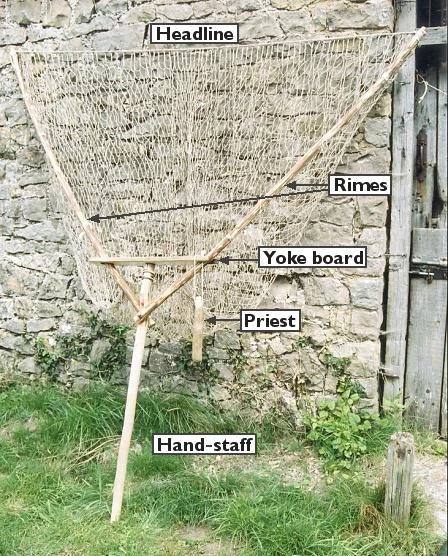Traditional fishing practices on the Severn Estuary
The lave net.
Blackrock Lave Net Fishermen, beside the Second Severn Crossing. From left to right: Bob Leonard, Richard Morgan a Martin Morgan.
The centuries-old fishing method of 'Lave Net fishing' continues along the banks of the River Severn.
The waters of the Severn Estuary are among the most dangerous in Wales but this has not deterred generations of fishermen from fishing its rich waters for salmon. Traditional Welsh methods of catching salmon survived particularly strongly in the area. Within living memory a range of methods were used, including putcher ranks, stopping boats, putts, drift nets and lave netting. Lave Net fishing is the only traditional method to have survived into the 21st century.
Unique historic significance
The number of lave netsmen has declined over the years and now can only be seen in the area of the Second Severn Crossing close to the villages of Sudbrook and Portskewett in Monmouthshire. The Blackrock Lave Net Fishermen Association, carry on a tradition that has a unique cultural and historical significance.
Fish are caught at low tides, known as spring tides, using a hand-held net. At one time fishermen were allowed to fish from February to August but this has since been restricted from June to August. At most, they can fish for an hour and a half at a time depending on weather conditions.
Fishing commences as it always has with the fishermen going down to the shore at Black Rock standing where their grandfathers and great-grandfathers once stood.
The basic technique for lave fishing is simple, the hand-staff is held in one hand and the headboard with the other, whilst the fingers are entwined in the bottom of the mesh feeling for the fish. The net is positioned in front of the fisherman, to face the run of the water. The fishermen consider wind direction and the height of the tide, with the optimum conditions being flat and calm.
At one time there was no need to divide the catch as there was sufficient salmon for everyone. Times have changed and commercial fishing using the lave net has not been viable on the estuary since before the Second World War. Prior to 1939 the fish were sent to Billingsgate Market in London.
The lave netsmen are as skilled as their forefathers but due to the diminishing fish stocks they are lucky if they catch more than a dozen fish for the season. They fish to keep their centuries old craft alive as Martin Morgan, Secretary of the Association explains "Lave fishing has a tradition going back a thousand years in Wales. My great-grandfather was a fisherman and passed his skills on through the family".
Background Reading
Severn Tide by Brian Waters. Published by J.M. & Sons Ltd (1947).
Nets and Coracles by J. Geraint Jenkins. Published by David and Charles (1974).


Comments - (1)
Mentioned in Brian Walters great book
Boshie Goulding